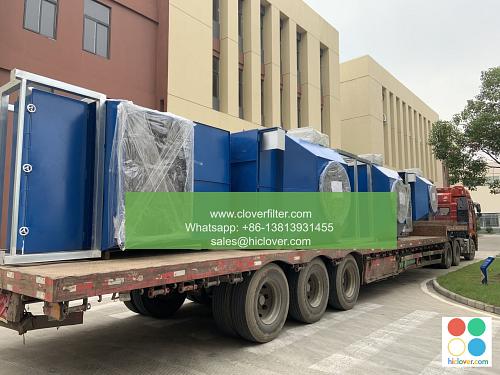Reducing Downtime with Automatic Roll Air Filters: A Game-Changer for Canada’s Electronics Industry

Canada’s electronics industry is a significant contributor to the country’s economy, with a wide range of companies involved in the design, manufacture, and distribution of electronic components and products. However, like many other industries, electronics manufacturing is not immune to downtime, which can have a significant impact on productivity, efficiency, and ultimately, the bottom line. One of the key causes of downtime in electronics manufacturing is the failure of air filtration systems, which are critical for maintaining a clean and controlled environment. This is where automatic roll air filters come into play, offering a game-changing solution for reducing downtime and improving overall efficiency.
Traditional air filtration systems typically consist of a series of filters that need to be manually replaced or cleaned on a regular basis. This can be a time-consuming and labor-intensive process, particularly in large-scale manufacturing facilities. Moreover, the frequency of filter replacement or cleaning can be difficult to predict, leading to unexpected downtime and disruptions to production. Automatic roll air filters, on the other hand, offer a continuous and uninterrupted supply of clean air, eliminating the need for manual filter replacement or cleaning.
These innovative filters work by automatically rolling out a new section of filter media as the existing one becomes saturated with contaminants. This process can be programmed to occur at predetermined intervals, ensuring that the air filtration system is always operating at peak efficiency. The benefits of automatic roll air filters are numerous, including reduced downtime, lower maintenance costs, and improved product quality. By minimizing the risk of filter failure and downtime, manufacturers can maintain a consistent and reliable production schedule, which is critical for meeting customer demand and staying competitive in the market.
In addition to reducing downtime, automatic roll air filters can also help to improve the overall quality of electronic components and products. By providing a consistent and controlled environment, manufacturers can reduce the risk of contamination and defect, which can have a significant impact on product quality and reliability. This is particularly important in the electronics industry, where even the smallest defect or contaminant can have a major impact on product performance and lifespan.
Another significant advantage of automatic roll air filters is their ability to reduce energy consumption and operating costs. By minimizing the need for manual filter replacement or cleaning, manufacturers can reduce the amount of labor required to maintain their air filtration systems. Additionally, automatic roll air filters can be designed to optimize airflow and minimize pressure drop, which can help to reduce energy consumption and lower operating costs.
Overall, automatic roll air filters offer a game-changing solution for Canada’s electronics industry, providing a reliable and efficient way to maintain a clean and controlled environment. By reducing downtime, improving product quality, and minimizing energy consumption, manufacturers can stay competitive in the market and maintain a strong reputation for quality and reliability.
The adoption of automatic roll air filters is expected to have a significant impact on the Canadian electronics industry, with many manufacturers already beginning to integrate these innovative filters into their production facilities. As the industry continues to evolve and grow, it is likely that we will see even more widespread adoption of automatic roll air filters, as manufacturers seek to improve efficiency, reduce downtime, and maintain a competitive edge in the market.
In conclusion, automatic roll air filters are a game-changer for Canada’s electronics industry, offering a reliable and efficient way to maintain a clean and controlled environment. By reducing downtime, improving product quality, and minimizing energy consumption, manufacturers can stay competitive in the market and maintain a strong reputation for quality and reliability.
Conclusion
In conclusion, the adoption of automatic roll air filters is a significant step forward for Canada’s electronics industry, offering a range of benefits that can help to improve efficiency, reduce downtime, and maintain a competitive edge in the market. As the industry continues to evolve and grow, it is likely that we will see even more widespread adoption of these innovative filters, as manufacturers seek to stay ahead of the curve and maintain a strong reputation for quality and reliability.
Frequently Asked Questions (FAQs)
Q: What are automatic roll air filters and how do they work?
A: Automatic roll air filters are a type of air filtration system that automatically rolls out a new section of filter media as the existing one becomes saturated with contaminants. This process can be programmed to occur at predetermined intervals, ensuring that the air filtration system is always operating at peak efficiency.
Q: What are the benefits of automatic roll air filters for the electronics industry?
A: The benefits of automatic roll air filters for the electronics industry include reduced downtime, lower maintenance costs, improved product quality, and minimized energy consumption.
Q: How do automatic roll air filters improve product quality?
A: Automatic roll air filters improve product quality by providing a consistent and controlled environment, which reduces the risk of contamination and defect. This is particularly important in the electronics industry, where even the smallest defect or contaminant can have a major impact on product performance and lifespan.
Q: Can automatic roll air filters be customized to meet the specific needs of my manufacturing facility?
A: Yes, automatic roll air filters can be customized to meet the specific needs of your manufacturing facility, including the type of filter media, the rate of filter replacement, and the overall design of the system.

